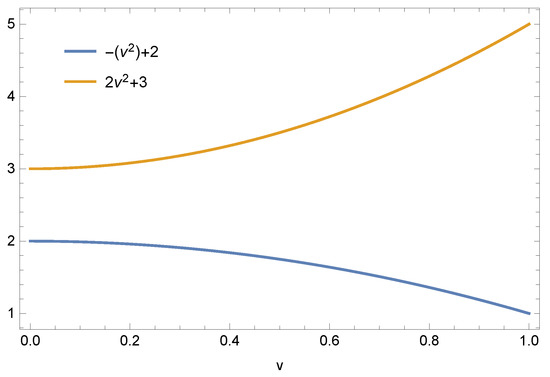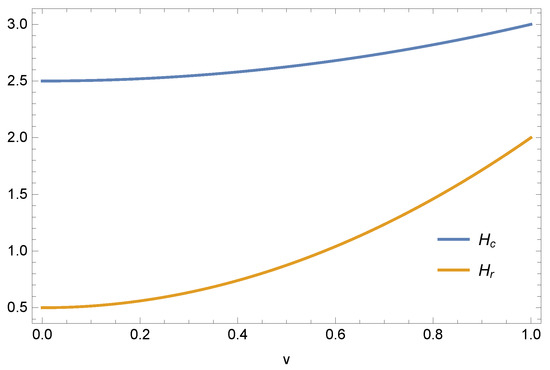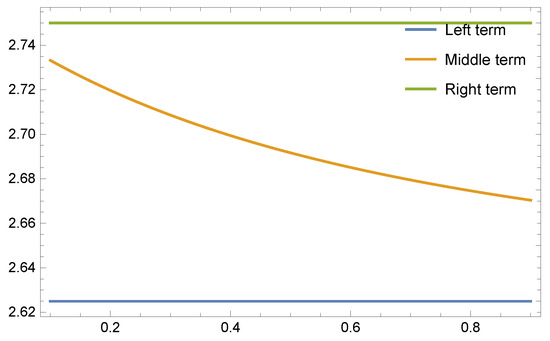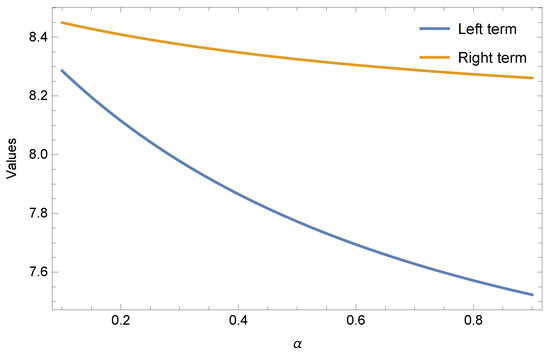Abstract
In this work, we use the idea of interval-valued convex functions of Center-Radius ()-order to give fractional versions of Hermite–Hadamard inequality. The results are supported by some numerical estimations and graphical representations considering some suitable examples. The results are novel in the context of -convex interval-valued functions and deal with differintegrals of the type. We believe this will be an important contribution to spurring additional research.
1. Introduction
An exciting and dynamic area of study is the theory of convexity. A lot of researchers extend and generalize its various forms in different ways by utilizing creative concepts and successful methodologies. With the help of this theory, we can create and arrange highly effective numerical techniques to address and resolve a wide variety of problems that arise in both pure and applied sciences. The idea of convexity has undergone much development, generalization, and extension in recent years. The theory of convex functions and the theory of inequalities are closely related, according to a number of research. Convex analysis and inequalities have developed into an alluring, fascinating, and useful field for researchers due to numerous generalizations and extensions. The Hermite–Hadamard inequality is an analogous form of a convex function and it must satisfy generalized convexity to establish the said inequality. Interested readers are directed to Refs. [1,2,3,4,5,6,7,8,9,10,11], who discuss convex functions and the associated inequalities that have been researched in recent years.
However, interval analysis can be a helpful method when measuring uncertainty issues. Although it has a rich history that dates back to Archimedes’ measurement of , it was not until Moore’s [12] first use of interval analysis for automated error analysis that it was given the attention it deserves. Numerous traditional integral inequalities have been extended to interval-valued functions and fuzzy-valued functions by Costa et al. [13], Flores-Franuli et al. [14], Chalco-cano et al. [15], and others. In particular, Zhao et al. [16] defined an interval h-convex function and using the interval-inclusion relation, demonstrated the related integral inequality. In 2021, Khan et al. [17], used the Kulisch–Miranker order to define an h-convex interval-valued function and certain inequalities for these types of convex functions were established. Because these two relations are in a partial order, any two intervals may not be comparable. As a result, finding a good order to investigate inequalities connected to interval-valued functions is an interesting task. Bhunia et al. [18] utilized the interval’s Center-Radius in 2014 to determine the cr-order, a new rank relationship. Given that this relationship is full-order, it allows the comparison of two intervals. For related works on interval valued inequalities, one can refer to Refs. [19,20,21,22,23,24].
The study of arbitrary order integrals and derivatives is known as fractional calculus. Despite the fact that fractional calculus was created not long after conventional calculus, numerous scientists and researchers are now looking into its origins and principles, particularly in light of the drawbacks of conventional calculus. For examples, see Refs. [25,26,27,28] and also a recent survey expository review article [29]. We draw attention to fractional integral inequalities that can be used to determine whether fractional ordinary and partial differential equations are unique. According to Refs. [30,31,32], there are linkages between integral inequalities and mathematical analysis, differential equations, discrete fractional calculus, difference equations, mathematical physics, and convexity theory.
It has been evident in recent years that mathematicians have a strong preference for presenting well-known inequalities using various novel conceptions of fractional integral operators. One may consult the works [33,34,35,36,37,38,39,40,41] included in this context.
Definition 1
(see Ref. [42]). A function is said to be convex for if and only if
holds true for all
We first provide the traditional Hermite–Hadmard (H-H) inequality for further discussion, which claims that (see Ref. [43]):
If the function be a convex function for , then
where
2. Preliminaries
Here, we provide some fundamental mathematics related to interval analysis that will be extremely useful throughout the article.
where .
Let represent, in that order, the sets of all closed intervals of , all positive closed intervals of , and all negative closed intervals of .
Let , then the center-radius form of interval can be represented as:
Definition 2.
For , , the center-radius order relation is defined as:
Definition 3.
Let be an interval-valued function given as . Then, we say is Interval Riemann integrable on if are Riemann integrable on i.e.,
Theorem 1.
Suppose given by and are interval-valued functions. If for all , then
Definition 4
(see Refs. [29,45]). Let (the set of all Lebesgue measurable functions), where . Then the left and right Riemann–Liouville (R-L) fractional integrals of order are defined as follows:
and
respectively, where is the Euler gamma function.
The major objective of this article is to provide a link between the concepts of interval-valued analysis and fractional order integral inequalities using total order relations, specifically the Center-Radius order relation. We first introduce a novel midpoint type H-H inequality for -convex interval-valued functions. Then, we propose integral inequalities for the product of two -convex interval-valued functions using differintegrals of the type.
The paper is structured as follows: After reviewing the prerequisite information and pertinent details on inequalities and interval-valued analysis in Section 2, we address -ordered interval-valued convex functions with numerical estimations and graphical representations in Section 3. The interval-valued H-H type inequalities for interval-valued convex functions are then derived in Section 4. Examples, numerical estimations and graphical behavior of the presented results are also taken into account to determine whether the predetermined results are advantageous. We conclude with Section 5, exploring a brief conclusion and possible areas for additional researches that are related to the findings in this paper.
3. Interval-Valued -Convex Function
Definition 5.
Let be non negative functions defined by . Then, we say the function as a -convex function if
Proposition 1.
Let defined by . Then, is interval valued -convex functions if and only if and are convex functions.
Proof.
Since and are convex functions, then for each , we have
and
If , then
This implies,
Otherwise, .
This implies
Now, from Definition 2, we can clearly see that,
This concludes the proof. □
Example 1.
Let be defined as
Then,
Figure 1 is the graphical representation of the interval valued convex function i.e., .

Figure 1.
Graphical behaviour of the CR interval valued convex functions given in Example 1.
From Figure 2, it is clearly seen that both the and are convex in nature and hence Example 1 is -convex function and Table 1 numerically proves this.

Figure 2.
Graphical behaviour of and of Example 1.

Table 1.
Numerical validation of Example 1 for , .
Example 2.
Let be defined as
Then,
Again, by Proposition 1, is also convex function.
4. Integral Inequalities Pertaining to R-L Fractional Integrals
This section establishes interval-valued fractional integral inequalities of the Hermite–Hadamard type, which include the -convex interval-valued function and are a product of two -convex interval-valued functions.
Theorem 2.
Let be an -convex interval-valued function on which is given by
for all , then
Proof.
Let be an -convex interval-valued function. Then, choosing
we obtain
Multiplying both sides of the above equations by and integrating the obtained results with respect to over , we find that
This implies that
Upon further simplification, we have
Following a similar procedure as above, we also have
Remark 1.
Choosing in Theorem 2, we retrieve the following result presented in Ref. [44], Remark 4.2.

Figure 3.
Graphical behaviour of Theorem 2 from the values of Table 2 for .
For further refinements, the next two theorems that follow are primarily concerned with proving interval fractional integral inequalities of the Pachpatte type.
Theorem 3.
Let be two -convex interval-valued functions on such that
for all , then
where
Proof.
By the hypothesis of -convex interval-valued functions, we can write
and
So that
Analogously, we have
Upon multiplying to both sides of the above equation (7) and then integrating over (0, 1), we obtain
Consequently,
This concludes the proof of Theorem 3. □
Now, we show the validity of Theorem 3 through Figure 4.

Figure 4.
Graphical behavior of Theorem 3 from the values of Table 3 for .
Theorem 4.
Let be two -convex interval-valued functions such that
for all then, the following interval-valued fractional inequality holds true:
where
Proof.
Suppose that are -convex interval-valued functions. Then, by the hypothesis, we have
Multiplying the equations (8) by and then integrating over we get
From the above developments, we find
Consequently, we have
which readily yields
This completes the proof of Theorem 4. □
5. Conclusions
This study examines an innovative approach of incorporating a Center-Radius order relation and the integral inequalities that go along with them. Hermite–Hadamard-type inequalities are generalized using the interval-valued Riemann–Liouville fractional operator. It will be very interesting to apply the idea of -convex interval-valued functions and fuzzy interval-valued functions to the Hadamard–Mercer type and other related integral inequalities in future studies.
It is feasible to analyze varieties of convex inequalities using the methods and concepts presented in this study, with potential applicability to topics such as optimization and differential equations that have convex shapes.
Author Contributions
Conceptualization, S.K.S. and H.A.; methodology, S.K.S., S.T. and Z.A.K.; software, S.K.S. and H.A.; validation, S.K.S.; formal analysis, S.T. and Z.A.K.; investigation, S.K.S.; resources, S.K.S.; data curation, S.T. and Z.A.K.; writing—original draft preparation, S.K.S. and S.T.; writing—review and editing, S.K.S.; supervision, S.K.S. and Z.A.K.; project administration, S.K.S.; funding acquisition, Z.A.K. All authors have read and agreed to the published version of the manuscript.
Funding
This research was supported by Princess Nourah bint Abdulrahman University Researchers Supporting Project number (PNURSP2023R8). Princess Nourah bint Abdulrahman University, Riyadh, Saudi Arabia.
Data Availability Statement
This study did not report any data.
Acknowledgments
We acknowledged Princess Nourah bint Abdulrahman University Researchers Supporting Project number (PNURSP2023R8). Princess Nourah bint Abdulrahman University, Riyadh, Saudi Arabia, and thanked all reviewers and academic editors.
Conflicts of Interest
The authors declare no conflict of interest.
References
- Alomari, M.; Darus, M.; Kirmaci, U.S. Refinements of Hadamard-type inequalities for quasi-convex functions with applications to trapezoidal formula and to special means. Comput. Math. Appl. 2010, 59, 225–232. [Google Scholar] [CrossRef]
- Mumcu, İ; Set, E.; Akdemir, A.O.; Jarad, F. New extensions of Hermite-Hadamard inequalities via generalized proportional fractional integral. Numer. Methods Partial Differ. Equ. 2021. [Google Scholar] [CrossRef]
- Liu, K.; Wang, J.; O’Regan, D. On the Hermite-Hadamard type inequality for Ψ-Riemann-Liouville fractional integrals via convex functions. J. Inequal. Appl. 2019, 2019, 27. [Google Scholar] [CrossRef]
- Xi, B.Y.; Qi, F. Some integral inequalities of Hermite-Hadamard type for convex functions with applications to means. J. Funct. Spaces Appl. 2012, 2012, 980438. [Google Scholar] [CrossRef]
- Kirmaci, U.S.; Özdemir, M.E. On some inequalities for differentiable mappings and applications to special means of real numbers and to midpoint formula. Appl. Math. Comput. 2004, 153, 361–368. [Google Scholar] [CrossRef]
- Srivastava, H.M.; Kashuri, A.; Mohammed, P.O.; Nonlaopon, K. Certain Inequalities pertaining to some new generalized fractional integral operators. Fractal Fract. 2021, 5, 160. [Google Scholar] [CrossRef]
- Dragomir, S.S.; Agarwal, R.P. Two inequalities for diferentiable mappings and applications to special means fo real numbers and to trapezoidal formula. Appl. Math. Lett. 1998, 11, 91–95. [Google Scholar] [CrossRef]
- Özdemir, M.E.; Avci, M.; Set, E. On some inequalities of Hermite-Hadamard type via m-convexity. Appl. Math. Lett. 2010, 23, 1065–1070. [Google Scholar] [CrossRef]
- Íşcan, Í. Hermite-Hadamard type inequalities for harmonically convex functions. Hacet. J. Math. Statist. 2013, 43, 935–942. [Google Scholar]
- Ahmad, H.; Tariq, M.; Sahoo, S.K.; Baili, J.; Cesarano, C. New estimations of Hermite–Hadamard type integral inequalities for special functions. Fractal Fract. 2021, 5, 144. [Google Scholar] [CrossRef]
- Dragomir, S.S.; Pearce, C.E.M. Selected Topics on Hermite-Hadamard Type Inequalities and Applications. RGMIA Monographs. 2000. Available online: http://rgmia.vu.edu.au/monographs/hermitehadamard.html (accessed on 1 July 2021).
- Moore, R.E. Interval Analysis; Prentice Hall: Englewood Cliffs, NJ, USA, 1966. [Google Scholar]
- Costa, T.M.; Román-Flores, H.; Chalco-Cano, Y. Opial-type inequalities for interval-valued functions. Fuzzy Set. Syst. 2019, 358, 48–63. [Google Scholar] [CrossRef]
- Flores-Franulič, A.; Chalco-Cano, Y.; Román-Flores, H. An Ostrowski type inequality for interval-valued functions. In Proceedings of the 2013 Joint IFSA World Congress and NAFIPS Annual Meeting (IFSA/NAFIPS), Edmonton, AB, Canada, 24–28 June 2013; Volume 35, pp. 1459–1462. [Google Scholar]
- Chalco-Cano, Y.; Flores-Franulič, A.; Román-Flores, H. Ostrowski type inequalities for interval-valued functions using generalized Hukuhara derivative. Comput. Appl. Math. 2012, 1, 457–472. [Google Scholar]
- Zhao, D.; An, T.; Ye, G.; Liu, W. New Jensen and Hermite-Hadamard type inequalities for h-convex interval-valued functions. J. Inequal. Appl. 2018, 2018, 302. [Google Scholar] [CrossRef]
- Khan, M.B.; Noor, M.A.; Mohammed, P.O.; Guirao, J.L.G.; Noor, K.I. Some integral inequalities for generalized convex fuzzy-interval-valued functions via fuzzy Riemann integrals. Int. J. Comput. Intell. Syst. 2021, 14, 158. [Google Scholar] [CrossRef]
- Bhunia, A.; Samanta, S. A study of interval metric and its application in multi-objective optimization with interval objectives. Comput. Ind. Eng. 2014, 74, 169–178. [Google Scholar] [CrossRef]
- Srivastava, H.M.; Sahoo, S.K.; Mohammed, P.O.; Baleanu, D.; Kodamasingh, B. Hermite-Hadamard type inequalities for interval-valued preinvex functions via fractional integral operators. Internat. J. Comput. Intel. Syst. 2022, 15, 8. [Google Scholar] [CrossRef]
- Sahoo, S.K.; Latif, M.A.; Alsalami, O.M.; Treanţă, S.; Sudsutad, W.; Kongson, J. Hermite-Hadamard, Fejér and Pachpatte-Type Integral Inequalities for Center-Radius Order Interval-Valued Preinvex Functions. Fractal Fract. 2022, 6, 506. [Google Scholar] [CrossRef]
- Costa, T.M. Jensen’s inequality type integral for fuzzy-interval-valued functions. Fuzzy Sets Syst. 2017, 327, 31–47. [Google Scholar] [CrossRef]
- Chalco-Cano, Y.; Lodwick, W.A. Condori-Equice. Ostrowski type inequalities and applications in numerical integration for interval-valued functions. Soft Comput. 2015, 19, 3293–3300. [Google Scholar] [CrossRef]
- Román-Flores, H.; Chalco-Cano, Y.; Lodwick, W.A. Some integral inequalities for interval-valued functions. Comput. Appl. Math. 2018, 37, 1306–1318. [Google Scholar] [CrossRef]
- Sahoo, S.K.; Al-Sarairah, E.; Mohammed, P.O.; Tariq, M.; Nonlaopon, K. Modified Inequalities on Center-Radius Order Interval-Valued Functions Pertaining to Riemann-Liouville Fractional Integrals. Axioms 2022, 11, 732. [Google Scholar] [CrossRef]
- Adjabi, Y.; Jarad, F.; Baleanu, D.; Abdeljawad, T. On Cauchy problems with Caputo-Hadamard fractional derivatives. Math. Meth. Appl. Sci. 2016, 40, 661–681. [Google Scholar]
- Zhou, X.S.; Huang, C.X.; Hu, H.J.; Liu, L. Inequality estimates for the boundedness of multilinear singular and fractional integral operators. J. Inequal. Appl. 2013, 2013, 303. [Google Scholar] [CrossRef]
- Liu, F.W.; Feng, L.B.; Anh, V.; Li, J. Unstructured-mesh Galerkin finite element method for the two-dimensional multi-term time-space fractional Bloch–Torrey equations on irregular convex domains. Comput. Math. Appl. 2019, 78, 1637–1650. [Google Scholar] [CrossRef]
- Kilbas, A.A.; Srivastava, H.M.; Trujillo, J.J. Theory and Applications of Fractional Differential Equations; North-Holland Mathematics Studies; Elsevier Science B.V.: Amsterdam, The Netherlands, 2006; Volume 204. [Google Scholar]
- Srivastava, H.M. An introductory overview of fractional-calculus operators based upon the Fox-Wright and related higher transcendental functions. J. Adv. Engrg. Comput. 2021, 5, 135–166. [Google Scholar] [CrossRef]
- Cloud, M.J.; Drachman, B.C.; Lebedev, L. Inequalities, 2nd ed.; Springer: Cham, Switzerland, 2014. [Google Scholar]
- Miller, K.S.; Ross, B. An Introduction to the Fractional Calculus and Fractional Differential Equations; Wiley: New York, NY, USA, 1993. [Google Scholar]
- Samko, S.G.; Kilbas, A.A.; Marichev, O.I. Fractional Integrals and Derivatives: Theory and Applications; Gordon & Breach Science Publishers: Yverdon, Switzerland, 1993. [Google Scholar]
- Sarikaya, M.Z.; Set, E.; Yaldiz, H.; Başak, N. Hermite–Hadamard inequalities for fractional integrals and related fractional inequalities. Math. Comput. Model. 2013, 57, 2403–2407. [Google Scholar] [CrossRef]
- Fernandez, A.; Mohammed, P.O. Hermite-Hadamard inequalities in fractional calculus defined using Mittag-Leffler kernels. Math. Meth. Appl. Sci. 2021, 44, 8414–8431. [Google Scholar] [CrossRef]
- Sarikaya, M.Z.; Yildirim, H. On Hermite-Hadamard type inequalities for Riemann-Liouville fractional integrals. Miskolc Math. Notes 2016, 17, 1049–1059. [Google Scholar] [CrossRef]
- Khan, T.U.; Khan, M.A. Hermite-Hadamard inequality for new generalized conformable fractional operators. AIMS Math. 2020, 6, 23–38. [Google Scholar] [CrossRef]
- Set, E. New inequalities of Ostrowski type for mapping whose derivatives are s-convex in the second-sense via fractional integrals. Comput. Math. Appl. 2012, 63, 1147–1154. [Google Scholar] [CrossRef]
- Ogulmus, H.; Sarikaya, M.Z. Hermite-Hadamard-Mercer type inequalities for fractional integrals. Filomat 2021, 35, 2425–2436. [Google Scholar] [CrossRef]
- Andrić, M.; Pečarič, J.; Perić, I. A multiple Opial type inequality for the Riemann-Liouville fractional derivatives. J. Math. Inequal. 2013, 2013 7, 139–150. [Google Scholar] [CrossRef]
- Sahoo, S.K.; Tariq, M.; Ahmad, H.; Kodamasingh, B.; Shaikh, A.A.; Botmart, T.; El-Shorbagy, M.A. Some Novel Fractional Integral Inequalities over a New Class of Generalized Convex Function. Fractal Fract. 2022, 6, 42. [Google Scholar] [CrossRef]
- Sahoo, S.K.; Mohammed, P.O.; Kodamasingh, B.; Tariq, M.; Hamed, Y.S. New Fractional Integral Inequalities for Convex Functions Pertaining to Caputo-Fabrizio Operator. Fractal Fract. 2022, 6, 171. [Google Scholar] [CrossRef]
- Niculescu, C.P.; Persson, L.E. Convex Functions and Their Applications; Springer: New York, NY, USA, 2006. [Google Scholar]
- Hadamard, J. Étude sur les propriétés des fonctions entières en particulier d’une fonction considérée par Riemann. J. Math. Pures. Appl. 1893, 58, 171–215. [Google Scholar]
- Shi, F.; Ye, G.; Liu, W.; Zhao, D. cr-h-convexity and some inequalities for cr-h-convex function. Filomat, 2022; submitted. [Google Scholar]
- Budak, H.; Tunç, T.; Sarikaya, M.Z. Fractional Hermite-Hadamard-type inequalities for interval-valued functions. Proc. Am. Math. Soc. 2020, 148, 705–718. [Google Scholar] [CrossRef]
Disclaimer/Publisher’s Note: The statements, opinions and data contained in all publications are solely those of the individual author(s) and contributor(s) and not of MDPI and/or the editor(s). MDPI and/or the editor(s) disclaim responsibility for any injury to people or property resulting from any ideas, methods, instructions or products referred to in the content. |
© 2023 by the authors. Licensee MDPI, Basel, Switzerland. This article is an open access article distributed under the terms and conditions of the Creative Commons Attribution (CC BY) license (https://creativecommons.org/licenses/by/4.0/).